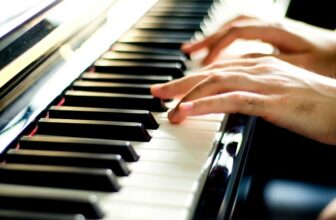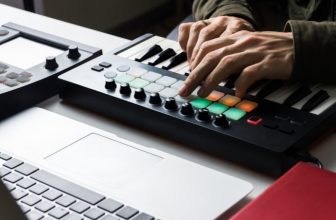Piano Pedals (What They Do, How to Use Them)
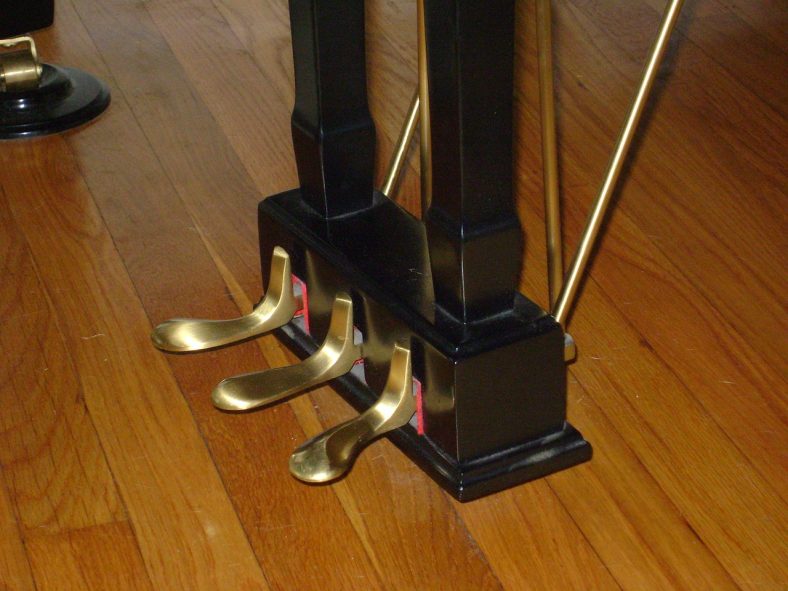
Standard pianos most commonly have three pedals. From left to right, these are usually a soft pedal, a sostenuto pedal, and a sustain pedal. However, these can vary slightly, particularly the middle pedal, which is sometimes a ‘mute’ pedal instead.
To understand how pedals work, you must first know how the piano works as well. The piano in the back of the keyboard has a set of large strings, which are hit by a hammer each time you play a key on the keyboard.
The corresponding hammer hits the right wire, playing the note. On the wires there are dampers, which are used to stop the wires from resonating to eternity, making the sound of the piano sharp and precise. Check out this article to learn more about this topic.
If you’d prefer to learn about this through a video, check out this great one below!
Contents
- Sustain pedal (Damper Pedal)
- Una corda pedal (Soft Pedal)
- Middle pedal (Usually a Sostenuto Pedal)
- What is the most important pedal on a piano?
- When should you use piano pedals?
- How do the pedals work on a piano?
- What is half-pedaling on a piano?
- What is delayed pedaling on a piano?
- Are there any other useful piano pedaling techniques?
- Should beginners use piano pedals?
- Piano Pedal Notation
- Piano Pedal Extender
- 2 vs 3 Pedal Pianos
- How long does it take to learn the piano?
- Can piano pedals be fixed?
- Summary
Sustain pedal (Damper Pedal)
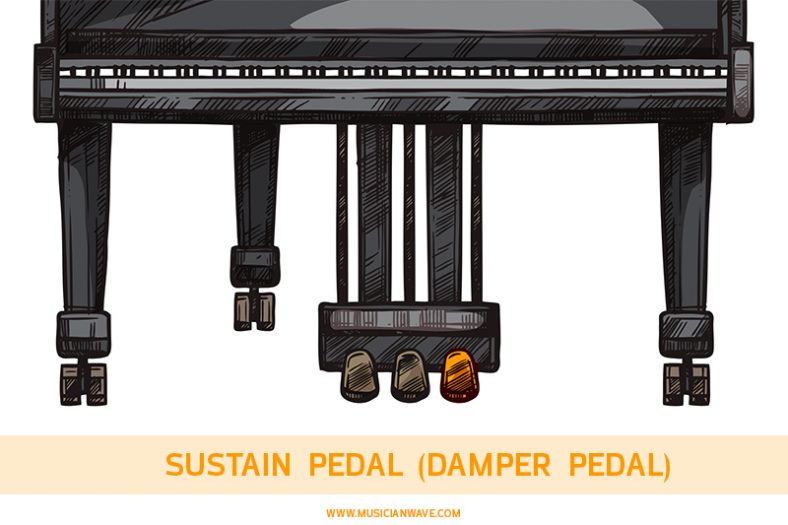
The sustain pedal is the most used one on the piano. It’s always located on the right side. It’s often called the damper pedal or sustaining pedal and its job is to raise all of the dampers from the wires in the back of the piano. This allows for a much more echoey and richer sound or legato effect.
Una corda pedal (Soft Pedal)
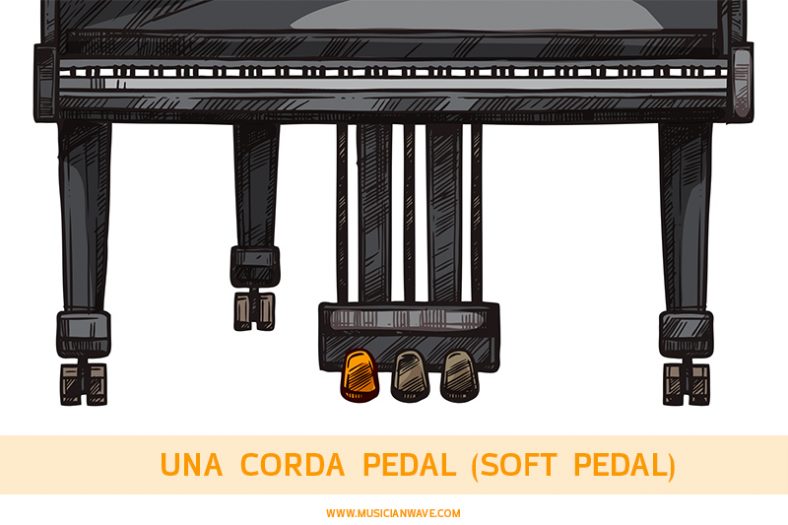
The left pedal is called the una corda pedal, meaning one wire (also known as the soft pedal). As you might have guessed, the point of this pedal is to move slightly all hammers and keys to the right, making them hit only one wire. This gives you the effect of a much softer and more precise sound, compared to the standard sound of the piano. When used properly, the left foot piano pedal will give you a real ethereal sound.
Middle pedal (Usually a Sostenuto Pedal)
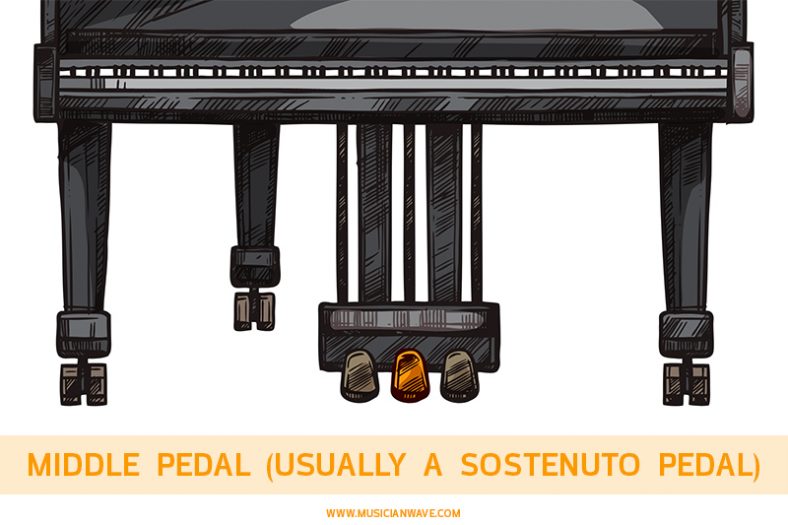
There are several different types of middle pedals, but the most common one is the sostenuto pedal. This is the type of pedal that’s similar to the sustain pedal, but the key difference is that it keeps the dampers up just for the selected notes you played before you pressed this pedal.
The functions of the third pedal can also be something else like a mute pedal or a bass sustain pedal, and naturally, you can probably guess the nature and effect by their names.
What is the most important pedal on a piano?
The most important and most used pedal on a piano is the sustain pedal. Because it gives you a louder and richer sound. It’s also the most used pedal when composing music. It gives you the ability to have seamless transitions between notes which otherwise wouldn’t be possible.
Even if you have a modern, digital piano, you’ll notice that almost all of the keyboards and pianos have at least an option for a digital sustain pedal to be put into use when playing them.
When should you use piano pedals?
Piano pedals are not meant to be used constantly. Because of their effects, they actually muddy the sound of music and are meant to be used as an effect, not as a standard way of how the piano should sound.
In some sheet music, you’ll find the notation on when and how you should use the pedals. But there’s nothing wrong with using pedals when you feel that it will give you a better-sounding end product. All that matters is that you don’t overuse them and everything else is more a question of taste than technique.
How do the pedals work on a piano?
Even though the pedals on the piano all work in a slightly different ways, they all have the same principles. All pedals on the piano are focused on affecting the wires and or hammers that hit them, whether through moving them (soft pedal) or raising the dampers (sustain and sostenuto pedals). Also, as they are mechanical, they will have an effect only as long as they are pressed.
What is half-pedaling on a piano?
Half-pedaling is a way of using the sustain pedal. This is where you press the sustain pedal only halfway through so that it just barely lifts the dampers of the wires. Even though this is a hard thing to master, once you break through it, you’ll get a whole new world of magical sound you can get from your piano by using this technique.
What is delayed pedaling on a piano?
Delayed pedaling is a frequently used technique (for the sustain pedal) that is done so by pressing the pedal after you’ve played a note and releasing it before you play the next one. This technique helps with your transitions so that it sounds smooth. I’d recommend you practice this to improve your overall performance.
Are there any other useful piano pedaling techniques?
Apart from half-pedaling and delayed-pedaling, there is also preliminary pedaling and simultaneous pedaling. Keep in mind that all these techniques require much practice in order to avoid unwanted noise.
Preliminary pedaling
Preliminary pedaling is done by pressing the sustain pedal before any notes are played. The more you leave it pressed, the more sustain you will get, resulting in a very spacious, rich, full, and bright sound. This is also a technique that you should practice if you want a better overall performance. The resulting note or sound will surprise you.
Simultaneous pedaling
As the name suggests, simultaneous pedalling is pressing down on the pedal at the same time you play a note or chord. This is done in order to accent particular notes.
This is a rather rare technique and hard to nail down because you need to press the note and pedal simultaneously at the exact moment (perfect unison). However, with enough practice and proper technique, this could prove a great weapon in your arsenal.
Should beginners use piano pedals?
Beginners should, in my opinion, first master their fingers before employing the piano pedals full-time. It’s okay to start off slow and gradually include the pedals as you go, but, without proper finger technique, pedals can easily mask mistakes that will later become bad habits for beginner pianists.
It would be easier to employ the pedals further down the line when you have solid technique, rather than forming bad habits from the get-go. Take your time and practice regularly.
For proper pedaling techniques, check out the video below.
Piano Pedal Notation
There is no standard piano pedal notation in use today, as there are no standard piano pedals as well. Throughout history, some composers didn’t at all notate the use of the pedals, leaving it all to the player to figure out, while many pianists did.
They usually used a grand staff sign to let you know when to press the sustain pedal and an asterisk on when to depress it (i.e. Fur Elisse).
Piano Pedal Extender
Because you need your feet to be flat on the ground to press the pedals correctly, when kids start learning how to play, they can have problems with reaching the pedals. So, piano pedal extenders are used to help them learn. These are just strap-on long levers that elongate the pedal from the piano.
2 vs 3 Pedal Pianos
When pianos don’t have a third pedal, it’s always the middle pedal missing.
There are different theories on why this is, but the most common and sensible explanation is that most of the average users won’t ever use the middle pedal as it’s meant to be used only by professionals who practice with it for years to get it right. You won’t miss a lot by not having the middle pedal on your piano.
Usually, modern or newer pianos will already have three pedals while some older acoustic pianos will have two.
How long does it take to learn the piano?
If you’re a total beginner, who never played an instrument before, you’re going to need at least 6 months to get to some decent playing level. Of course, all of this is highly personal, because if you’re talented or have better ears, you’ll get it on much quicker then someone who doesn’t have those skills.
The point is, everybody can learn it, it’s just a matter of time and work you’re ready to put in practice.
Some useful resources are:
The 10 Best Online Piano Lessons (2022)
10 Great Apps for Learning Piano and Keyboard (Android and iOS)
The 10 Best Piano/Keyboard Books for Beginners
10 Easy Piano Songs for Beginners (With Video Tutorials)
How Long Does it Take to Learn Piano?
How To Teach Yourself Piano At Home (10 Steps)
How do you properly play (press) piano pedals?
The proper way to press a piano pedal is to have your heel on the floor and your toes on the pedal lever. Keep in mind that the heel should always be on the floor, even when pressing, so, no lifting your foot. You will have enough pressure with the ball of your foot so there will be no need for lifting your foot. And naturally, proper posture while playing will also aid you in this.
Can piano pedals be fixed?
Most of the pedals can be fixed when something breaks, as they are mechanical. In the rare case that the breakage is such that it can’t be fixed, you can always change the whole mechanism, but it will of course cost much more.
Summary
I hope that this article has helped you learn all you need to know about piano pedals. Even though they are not that often talked about, they are an important piece of the piano, that gives it that edge through which you can achieve so much more when you use it the right way. While older pianos may have had just two pedals, the standard modern piano has three pedals in its pedal configuration. This is the current form since the late 19th century.

